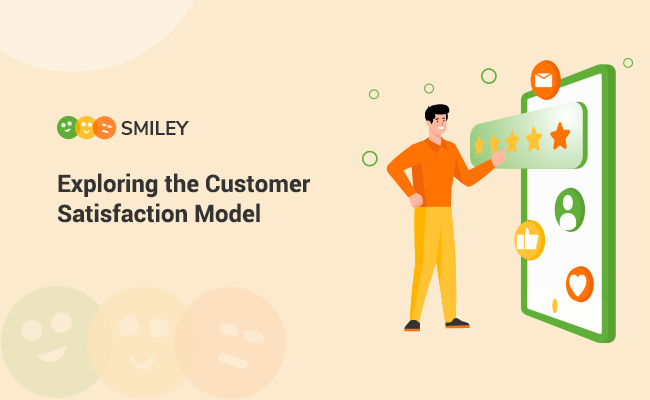Customer satisfaction has become more than just a buzzword; it’s the lifeline of any successful enterprise. Understanding and implementing an effective customer satisfaction model is crucial for not only retaining your existing customer base but also attracting new ones. In this comprehensive guide, we will delve into the intricacies of a customer satisfaction model, its significance, and practical steps to enhance it.
Customer satisfaction is the gold standard. It’s not just about making your customers happy; it’s about creating an experience that keeps them coming back for more. In this article, we will unravel the customer satisfaction model, its underlying principles, and how to put it into practice to benefit your business.
What Is a Customer Satisfaction Model?
At its core, a customer satisfaction model is a structured approach that enables businesses to understand and enhance the satisfaction levels of their customers. It goes beyond simply delivering a product or service; it involves identifying and exceeding customer expectations.
The first step in this process is identifying what your customers expect from your business. This can be done through various methods such as surveys, focus groups, or analyzing feedback data. By understanding their needs and desires, you can tailor your offerings to meet or even exceed those expectations.
Why Is Customer Satisfaction Important?
Customer satisfaction, importance, business success, customer loyalty, word-of-mouth marketing. Customer satisfaction is crucial for the success of any business. It goes beyond simply meeting the needs and expectations of customers; it is about exceeding them. When customers are satisfied with their experience, they are more likely to become loyal patrons who continue to support your business. One of the key reasons why customer satisfaction is important is its direct impact on business success. Satisfied customers are more likely to make repeat purchases and become loyal advocates for your brand.
They not only continue to buy from you but also recommend your products or services to their friends, family, and colleagues through positive word-of-mouth marketing. Moreover, customer satisfaction plays a significant role in building trust and credibility. When customers have a positive experience with your business, they develop trust in your brand and are more likely to choose you over competitors. This trust can lead to long-term relationships that benefit both parties involved.
Customer Retention
The key to sustainable business growth lies in keeping your existing customers satisfied. _Statistics reveal that acquiring a new customer demands an expenditure five times greater than retaining an existing one. Elevating customer satisfaction levels significantly contributes to bolstering customer loyalty._
Brand Loyalty
Satisfied customers are not just loyal; they become brand advocates. They’re more likely to recommend your products or services to friends and family, expanding your customer base through word-of-mouth marketing.
Word-of-Mouth Marketing
Positive customer experiences are shared, and in today’s digital age, a single satisfied customer can reach hundreds or even thousands through social media and online reviews.
Components of a Customer Satisfaction Model
Customer satisfaction has become the cornerstone of success. Companies are constantly striving to understand and meet the ever-evolving expectations of their customers. To achieve this, businesses rely on a customer satisfaction model that encompasses various components, including customer expectations, product quality; service quality, perceived value, and ultimately customer loyalty.
Identifying Customer Expectations
Understanding what your customers expect from your business is the first step in creating a successful customer satisfaction model.
Measuring Customer Satisfaction
Measuring customer satisfaction has become more crucial than ever. Understanding how your customers perceive your products or services is essential for maintaining a successful and thriving business. By accurately measuring customer satisfaction, you gain valuable insights that can help drive improvements, enhance customer loyalty, and ultimately increase revenue.
Surveys and Feedback
Regularly collecting feedback through surveys and direct interactions provides valuable insights into customer satisfaction levels.
Net Promoter Score
The Net Promoter Score (NPS) is a widely used metric that gauges customer loyalty and satisfaction based on a single question: “How likely are you to recommend our company/product to a friend or colleague?”
Addressing Customer Feedback
Once you have feedback, it’s essential to act upon it promptly. This builds trust and shows your commitment to customer satisfaction.
Building Your Customer Satisfaction Model
Setting Clear Objectives
Clearly defined goals help in creating a focused and effective customer satisfaction model.
Gathering Customer Data
Quantitative Data
Data-driven decision-making is essential. Analyze quantitative data such as sales figures, customer retention rates, and website analytics.
Qualitative Data
Qualitative data, like customer comments and suggestions, provides a deeper understanding of customer sentiment.
Analyzing and Interpreting Data
Data is only valuable when you can derive insights from it. Interpret the data to identify areas for improvement.
Implementing Strategies for Improvement
Personalization and Customization
Tailoring your products or services to meet individual customer needs enhances satisfaction.
Effective Communication
Open and transparent communication with customers builds trust and helps in managing expectations.
Timely Issue Resolution
Addressing customer issues promptly and efficiently demonstrates your commitment to their satisfaction.
Monitoring and Measuring Progress
Key Performance Indicators
Set KPIs to track the effectiveness of your customer satisfaction model.
Continuous Feedback Loop
Maintain an ongoing feedback loop to adapt and improve your strategies continually.
Conclusion
In today’s competitive business landscape, customer satisfaction isn’t optional; it’s a necessity. By understanding the components of a customer satisfaction model and implementing effective strategies, you can build strong customer relationships, foster brand loyalty, and achieve sustainable growth.
Frequently Asked Questions
1. What is the primary goal of a customer satisfaction model?
– The primary goal is to enhance customer satisfaction by understanding their expectations and continuously improving products or services.
2. How can businesses measure customer satisfaction?
– Businesses can measure customer satisfaction through methods like surveys, feedback collection, and the Net Promoter Score (NPS).
3. What role does technology play in customer satisfaction?
– Technology, such as CRM systems and AI-powered chatbots, can streamline customer interactions and improve satisfaction levels.
4. What challenges do businesses face in maintaining high customer satisfaction?
– Challenges include managing customer expectations, addressing negative feedback, and balancing resources.

